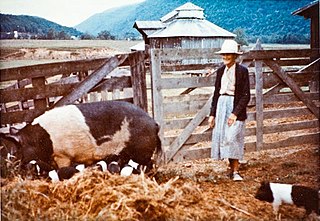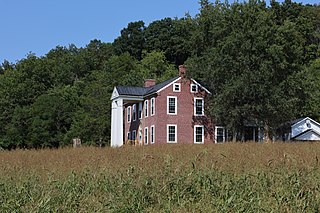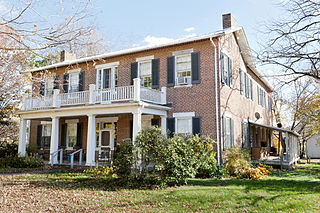
Masontown is a town in western Preston County, West Virginia, United States. The population was 510 at the 2020 census. It is part of the Morgantown metropolitan area.

A round barn is a historic barn design that could be octagonal, polygonal, or circular in plan. Though round barns were not as popular as some other barn designs, their unique shape makes them noticeable. The years from 1880 to 1920 represent the height of round barn construction. Round barn construction in the United States can be divided into two overlapping eras. The first, the octagonal era, spanned from 1850 to 1900. The second, the true circular era, spanned from 1889 to 1936. The overlap meant that round barns of both types, polygonal and circular, were built during the latter part of the nineteenth century. Numerous round barns in the United States are listed on the National Register of Historic Places.

The Stephen Harnsberger House, also known as the Harnsberger Octagonal House, is an historic octagon house located on Holly Avenue in Grottoes, Virginia.

The Allstadt House and Ordinary was built about 1790 on land owned by the Lee family near Harpers Ferry, West Virginia, including Phillip Ludwell Lee, Richard Bland Lee and Henry Lee III. The house at the crossroads was sold to the Jacob Allstadt family of Berks County, Pennsylvania in 1811. Allstadt operated an ordinary in the house, and a tollgate on the Harpers Ferry-Charles Town Turnpike, while he resided farther down the road in a stone house. The house was enlarged by the Allstadts c. 1830. The house remained in the family until the death of John Thomas Allstadt in 1923, the last survivor of John Brown's Raid.

Advance Mills, also known as Fray's Mill, is an unincorporated community in Albemarle County, Virginia.

The Kuykendall Polygonal Barn was an early 20th-century polygonal barn in the South Branch Potomac River valley near Romney in Hampshire County, West Virginia, United States. The Kuykendall Polygonal Barn was the only 15-sided barn built in West Virginia, and one of only a few such known to have been constructed in the United States. The barn utilized a number of sophisticated technological innovations not found in West Virginia's other round and polygonal barns. The Kuykendall Polygonal Barn was listed on the National Register of Historic Places on 9 July 1985.

John, David, and Jacob Rees House, also known as Lefevre Farm, is a historic home located at Bunker Hill, Berkeley County, West Virginia. It is an L-shaped, log, stone-and-brick dwelling on a stone foundation. It measures 45 feet wide by 70 feet deep, and was built in three sections, the oldest, three-bay log section dating to about 1760. The two-story, three-bay rubble stone section is in the Federal style and built in 1791. The front section was built about 1855 and is a five-bay-wide, 2+1⁄2-story building in the Greek Revival style. Also on the property is a small stone spring house and log barn.

Rush-Miller House is a historic home located near Smoketown, Berkeley County, West Virginia. It is a two-story, L-shaped, stone dwelling with a gable roof. It is five bays wide and three bays deep. The rear ell was built about 1810 in the Federal style. The front two-story section was added about 1873. It is five bays wide and is of pounded rubble limestone in the Romanesque style. Also on the property is a stone bank barn (1909), stone and frame smoke house, and a stone springhouse.

Miller Tavern and Farm is a historic home and farm located near Martinsburg, Berkeley County, West Virginia. The main house is L-shaped and consists of a vernacular tavern building, built about 1813, to which is appended a Greek Revival-style "I"-house built about 1831. The house of painted brick and wood construction. It has an intersecting gable roof structure clad in standing seam metal. Also on the contributing property is the Dr. John Magruder House, privy, smokehouse, barn, bank barn, and two sheds.

Adaland is a historic house located at Berryburg, Barbour County, West Virginia.

The Manor, also known as Peter and Jesse Hutton Farm, is a historic home located near Petersburg, Grant County, West Virginia. It was built about 1830, and is a 2+1⁄2-story, L-shaped brick dwelling in the Greek Revival style. It features a two-story portico with pediment supported by four massive square columns. Also on the property are dependencies: a kitchen, meathouse, small storage barn, and large frame barn.

James F. Murray House, also known as Murray-Abrams House, was a historic home located at Chester, Hancock County, West Virginia. It was built 1904–1905, and was a blond brick, L-shaped dwelling in a combined Classical Revival / American Foursquare style. It featured a deep wraparound porch and porte cochere and slate covered intersecting hipped roofs. Also on the property is a large 2+1⁄2-story frame barn built in 1903. It was the home of James Fraser Murray, (1844-1925), an individual important in the Northern Panhandle's developing oil industry. It was listed on the National Register of Historic Places in 1990.

Rankin Octagonal Barn is a historic octagonal barn located near Silverton, Jackson County, West Virginia. It was built about 1890, and is an eight-sided frame structure covered with vertical wide board siding. Each side of the octagon measures 24 feet in length. It features a central cupola to provide light and ventilation.

Hamilton Round Barn is a historic round barn located near Mannington, Marion County, West Virginia. It was built in 1911, and is circular in shape, measuring 66 feet in diameter and 75 feet high at the center. It features a gambrel roof topped by a six-sided cupola. The barn has horizontal clapboard siding of poplar, painted white, and a slate roof. In 1985, it was one of only five round and polygonal barns standing in West Virginia. The barn was purchased by the West Augusta Historical Society in 1983, and is operated as a museum.

Fort Hill, also known as Fort Hill Farm, is a historic plantation house and national historic district located near Burlington, Mineral County, West Virginia. The district includes 15 contributing buildings, 1 contributing site, and 2 contributing structures. The main house was completed in 1853, and is a two-story, L-shaped brick dwelling composed of a side-gable-roofed, five-bay building with a rear extension in the Federal style. It features a three-bay, one-story front porch supported by 4 one-foot-square Tuscan order columns. Also on the property are a number of contributing buildings including a washhouse and cellar, outhouse, a dairy and ice house, a meat house, a garage, a hog house, poultry houses, a bank barn with silo, and a well. The family cemetery is across the road west of the main house. Located nearby and in the district is "Woodside," a schoolhouse built about 1890, and a tenant house and summer kitchen.

The Harnsberger Octagonal Barn, also known the Mt. Meridian Octagonal Barn, is located near Grottoes, Virginia. Built about 1867, the barn is possibly the only example of such a barn in Virginia, as the building style was more popular in the expanding midwestern United States in the immediate post-American Civil War era than in economically depressed Virginia. The octagonal style was popularized in 1853 by A Home For All, or the Gravel Wall and Octagon Mode of Building by Orson Squire Fowler.

The El Tovar Stables at the south rim of the Grand Canyon were built about 1904, at the same time the nearby El Tovar Hotel was built, to house the animals used in general transportation around the park. Collectively called the "transportation department" in the early 20th century, the three structures comprised a horse barn or stable, a mule barn and a blacksmith shop.

Zehmer Farm is a historic home and farm complex located near McKenney, Dinwiddie County, Virginia. The farmhouse was built about 1905, and is a one-story, frame L-shaped dwelling with a broad hipped roof and wings added to both sides. Also on the property are a collection of outbuildings and farm structures – including animal shelters, corn crib, flue-cured tobacco barns, dairy barn and milk houses, and the sites of tenant houses, a butcher house, fire-cured tobacco barns and a sawmill.
Christian and Katharina Herschler House, Barn, and Outbuildings Historic District are historic buildings located in Franklin, Iowa, United States. The historic district, now known as the Christian Herschler Winery, is located on the edge of town. It was listed on the National Register of Historic Places in 1996. At the time of its nomination it included three contributing buildings: the house (1865), barn (1865) and a shed/summer kitchen. It also includes two noncontributing buildings: a two-room brick structure and a cement foundation. The Herschlers raised their own grapes and operated the town's only winery.
August Nus Polygonal Barn is a historic building located east of Arlington, Iowa, United States. Built in 1906, this was one of four flat roofed barns that were known to exist in Iowa, and it was the oldest of the four. The 12-sided structure with horizontal wood siding was built around a central silo that extends above the barn. Eventually, it had a cone shaped roof. The barn is 60-foot (18 m) in diameter, and the silo is 14 feet (4.3 m) in diameter. The barn was listed on the National Register of Historic Places in 1986.





















